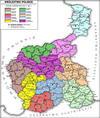| Suwałki Governorate Сувалкская губерния | |||||||||||
|---|---|---|---|---|---|---|---|---|---|---|---|
| Governorate of Congress Poland | |||||||||||
| 1867–1915 | |||||||||||
 Location in the Russian Empire | |||||||||||
| Capital | Suwałki | ||||||||||
| Area | |||||||||||
| • Coordinates | 54°5′N 22°56′E / 54.083°N 22.933°E | ||||||||||
| History | |||||||||||
• Established | 1867 | ||||||||||
• Disestablished | 1915 | ||||||||||
| |||||||||||
| Today part of | Poland Lithuania Belarus | ||||||||||
Suwałki Governorate[a] was an administrative-territorial unit (guberniya) of Congress Poland of the Russian Empire, which had its seat in the city of Suwałki. It covered a territory of about 12,300 square kilometres (4,700 sq mi).
YouTube Encyclopedic
-
1/1Views:377
-
Who Were the Germans From Lithuania? IAGL Presentation at IGGP 2021
Transcription
History

In 1867, the territories of the Augustów Governorate and the Płock Governorates were re-organised to form the Płock Governorate, the Suwałki Governorate (consisting mostly of the Augustów Governorate territories) and a recreated Łomża Governorate.
After World War I, the governorate was split between the Second Polish Republic and Lithuania, mostly along ethnic lines (with an exception of the area in the proximity of Puńsk and north of Sejny).[1] The Polish part, known as Suwałki Region, was incorporated into the Białystok Voivodeship. The Lithuanian region of Suvalkija was named after the governorate.
Demographics and economy
According to contemporary Russian Empire statistics, from 1889 the Suwałki Governorate was predominantly Lithuanian since they comprised 57.8% of the population.[2] Lithuanians formed a majority only in the northern part of the governorate in the counties of Kalvarija, Marijampolė, Naujamiestis, Vilkaviškis as well as the eastern part of the Sejny county. Poles were in a majority in the southern part of the governorate in the counties of Suwałki, Augustów and in the western part of the Sejny county.[3][4]
Before World War I, the Suwałki Governorate was economically the least developed area of Congress Poland. It was characterised by the lowest agricultural productivity and profitability. In 1912, the governorate had a population density of just 45 persons per km2, compared to Congress' average of 103 persons per km2.[5]
| Population in 1897[6] | ||
|---|---|---|
| Nationality | People | Percent |
| Lithuanians | 304,500 | 52% |
| Poles | 134,000 | 23% |
| Jews | 59,100 | 10% |
| Germans | 30,500 | 5% |
| Belarusians | 26,600 | 5% |
| Russians | 24,500 | 4% |
| Others | 3,700 | .7% |
| Total | 582,900 | 100% |
Administrative divisions
It was divided into seven counties:[7]

| County | County Seat | Major Towns | |
|---|---|---|---|
| Augustów County | Augustów | Lipsk • Raczki • Sopoćkinie | |
| Kalvarija County | Kalvarija | Liudvinavas • Alytus • Simnas | |
| Marijampolė County | Marijampolė | Balbieriškis • Pilviškės • Panemunė • Prienai • Zapyškis | |
| Sejny County | Sejny | Kapčiamiestis • Lazdijai • Seirijai | |
| Suwałki County | Suwałki | Bakałarzewo • Filipów • Przerośl • Wiżajny | |
| Naujamiestis County | Naujamiestis | Sudargas • Šakiai | |
| Vilkaviškis County | Vilkaviškis | Virbalis • Vištytis |
References
- ^ Łossowski 1996, p. 51.
- ^ Šenavičienė, Ieva (1999). "Tautos budimas ir blaivybės sąjūdis" (PDF). Istorija. 40: 3. ISSN 1392-0456. Retrieved 2007-12-07.
- ^ Łossowski, Piotr (1996). Konflikt polsko-litewski 1918-1920 (in Polish). Książka i Wiedza. pp. 10, 15. ISBN 978-8305127691.
- ^ Borzęcki, Jerzy (2008). The Soviet-Polish Peace of 1921 and the Creation of Interwar Europe. Yale University Press. p. 4. ISBN 978-0300121216.
- ^ Czerep, Stanisław (2007–2008). "Charakterystyka obszaru Mazur i północnego Podlasia, objętych operacją mazursko-augustowską w lutym 1915 roku" (PDF). Studia Podlaskie (in Polish). 17. University of Białystok: 89. ISSN 0867-1370.
- ^ Nikolajew, Christina Juditha (2005). Zum Zusammenhang zwischen nationaler Identitätsbildung und Katholischer Kirche in Litauen (PDF) (in German). Eberhard Karls University of Tübingen. p. 16.[permanent dead link]
- ^ Jonas Zinkus; et al., eds. (1988). "Suvalkų gubernija". Tarybų Lietuvos enciklopedija (in Lithuanian). Vol. IV. Vilnius, Lithuania: Vyriausioji enciklopedijų redakcija. pp. 136–137.
- ^
- Russian: Сувалкская губерния, romanized: Suvalkskaya guberbiya
- Polish: Gubernia suwalska
- Lithuanian: Suvalkų gubernija
- Belarusian: Сувалкаўская губерня


